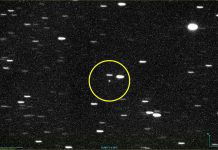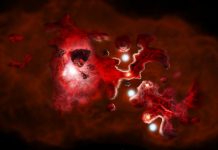
The James Webb Space Telescope (JWST) has made a groundbreaking discovery, revealing a wide variety of carbon-rich gases around a very low-mass star.
This finding could shed light on how planets form around such stars.
Planets are known to form in disks of gas and dust that orbit young stars, and the Mid-Infrared Disk Survey (MINDS) led by Thomas Henning from the Max Planck Institute for Astronomy aims to understand the chemistry and physical properties of these disks.
In a recent study, researchers examined the area around a very low-mass star, ISO-ChaI 147, which has only 0.11 times the mass of our Sun.
This study, published in the journal Science, used the Mid-Infrared Instrument (MIRI) on JWST to observe the star’s surrounding disk.
“These observations are not possible from Earth because our atmosphere absorbs the relevant gas emissions,” explained lead author Aditya Arabhavi from the University of Groningen. “Before, we could only detect acetylene (C2H2) from this object. JWST’s higher sensitivity allowed us to find weaker emissions from less abundant molecules.”
The MINDS collaboration discovered gas at temperatures around 300 Kelvin (about 30 degrees Celsius), rich in carbon-bearing molecules but lacking oxygen-rich ones. This composition is very different from disks around stars like the Sun, where molecules like water and carbon dioxide are more common. For example, the disk around the star PDS 70 contains large amounts of water vapor, highlighting how disks around very low-mass stars evolve differently.
The amount and distribution of material in these disks determine the size and number of planets that can form. Observations suggest that rocky planets, similar in size to Earth, form more efficiently around very low-mass stars than gas giants like Jupiter. Consequently, these small stars, which are the most common in the universe, host the majority of rocky planets.
The JWST study found that the gas in the planet-forming region of ISO-ChaI 147 is rich in carbon. This could be because carbon is removed from the solid material forming rocky planets, potentially explaining why Earth is relatively carbon-poor. JWST’s MIRI instrument revealed the richest hydrocarbon chemistry seen in a protoplanetary disk, including 13 carbon-bearing molecules such as benzene (C6H6) and the first detection of ethane (C2H6) outside our Solar System. The team also identified ethylene (C2H4), propyne (C3H4), and the methyl radical (CH3) for the first time in a protoplanetary disk.
“Many primary atmospheres of these planets will likely be dominated by hydrocarbon compounds rather than oxygen-rich gases like water and carbon dioxide,” said Henning. The study showed that carbon-rich gas moves quickly into the zone where terrestrial planets usually form in these disks.
The team used MIRI’s spectrograph to break down the infrared light from the disk into small wavelength ranges, identifying individual molecular signatures. This method revealed a wealth of organic molecules, but no water or carbon monoxide was detected.
The researchers plan to expand their study to more disks around very low-mass stars to better understand how common these carbon-rich planet-forming regions are. “Further study will help us understand how these molecules form,” Henning explained.
“Several features in the data are still unidentified, requiring more spectroscopy to fully interpret our observations.”
Source: Max Planck Society.



